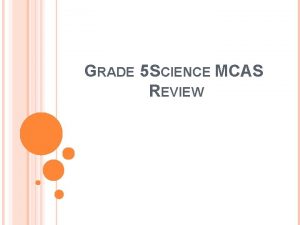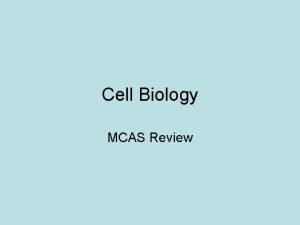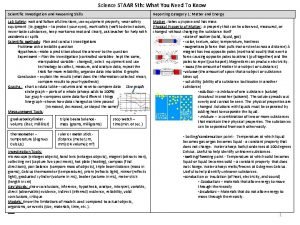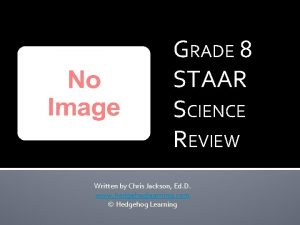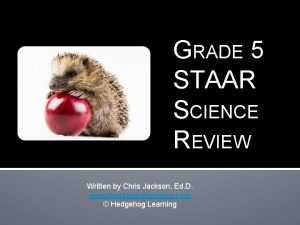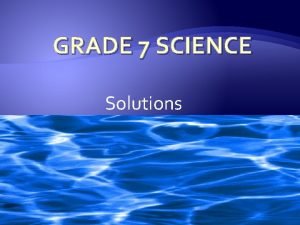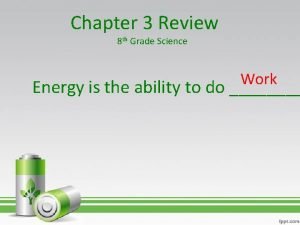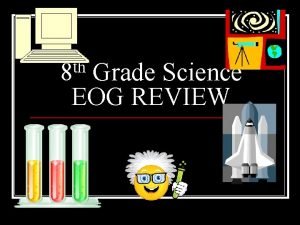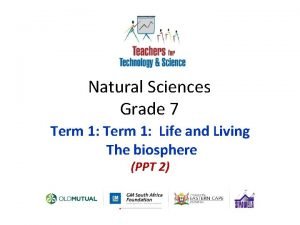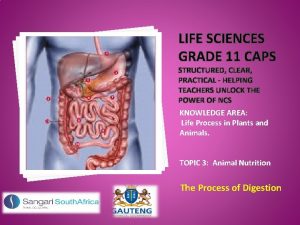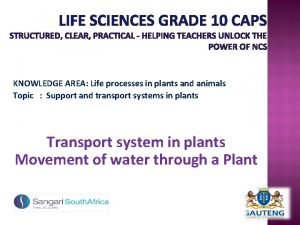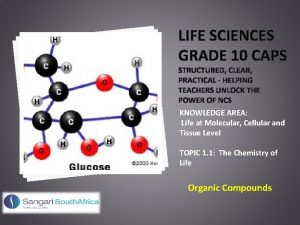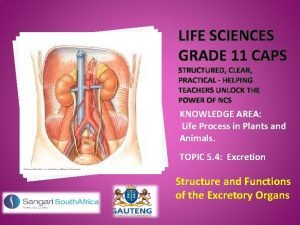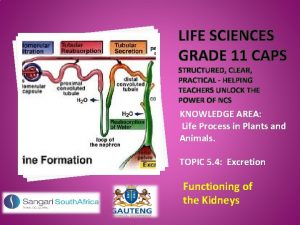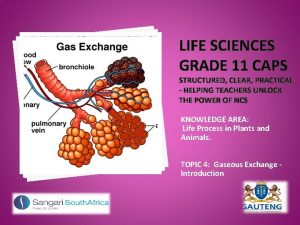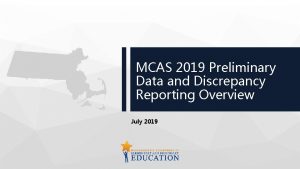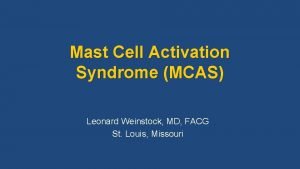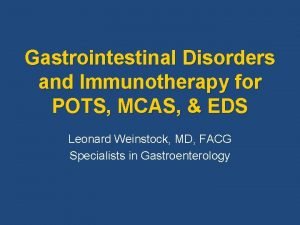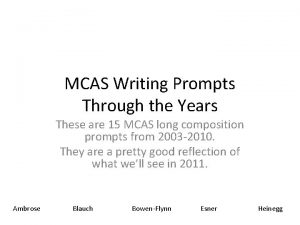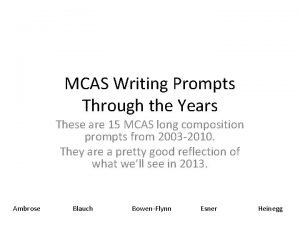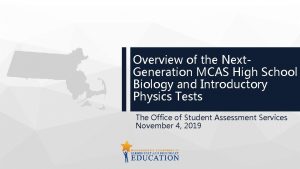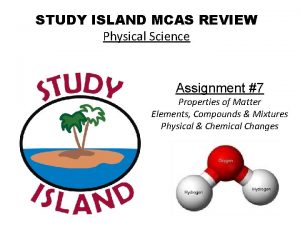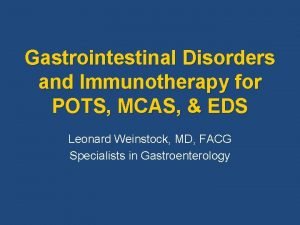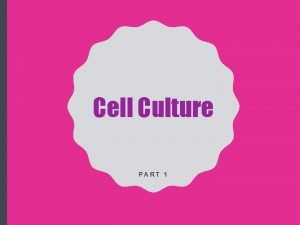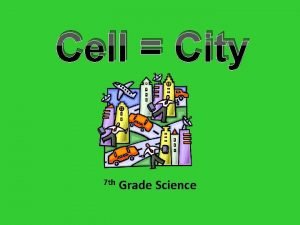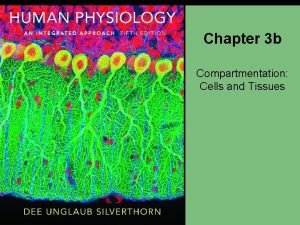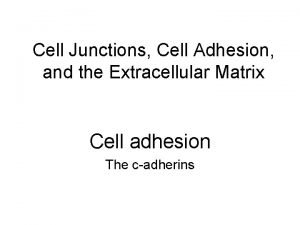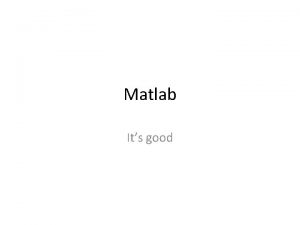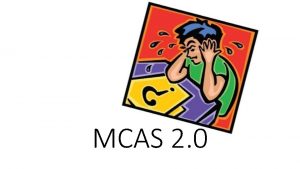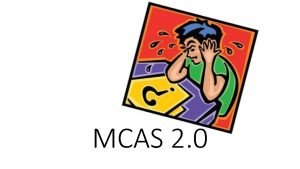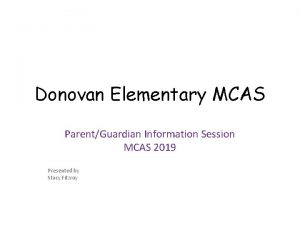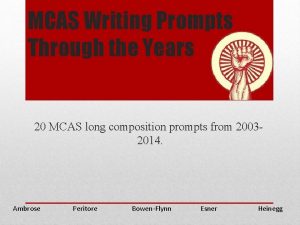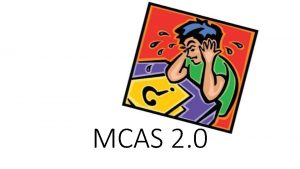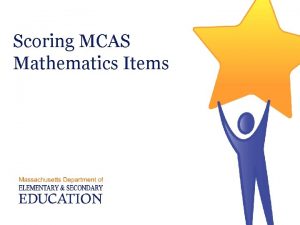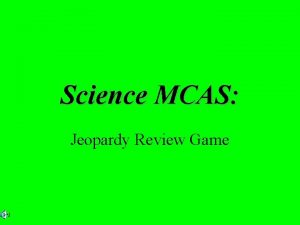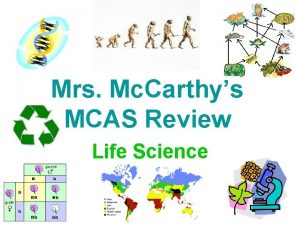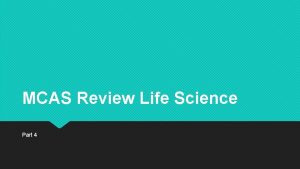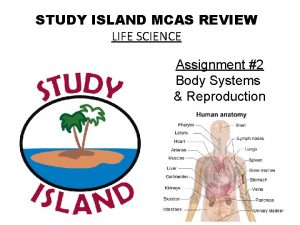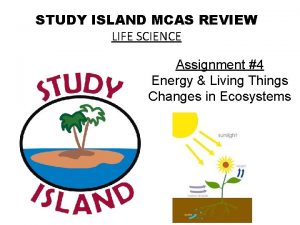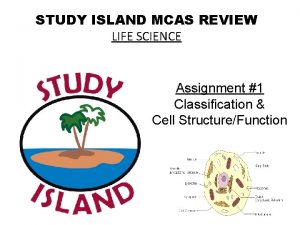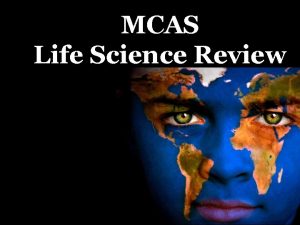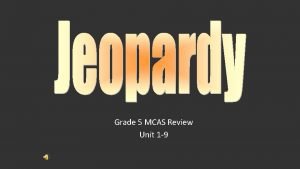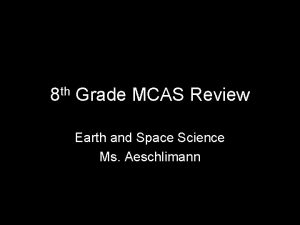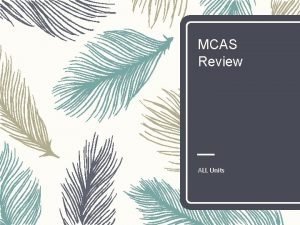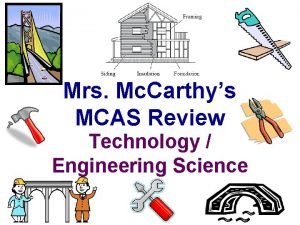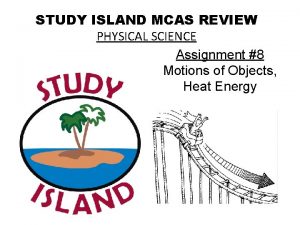th 7 grade Life Science MCAS review Cell







































































- Slides: 71

th 7 grade Life Science – MCAS review

Cell Theory • Cell - A cell is the smallest unit that is capable of performing life functions. • All living things are made up of cells. • All cells come from preexisting cells through cell division. • There are two types of cells: 1) Prokaryotic 2) Eukaryotic

Prokaryotic • Do not have structures surrounded by membranes • Few internal structures • One-celled organisms, Bacteria

Eukaryotic • Contain organelles surrounded by membranes • Most living organisms Plant Animal

“Typical” Animal Cell

“Typical” Plant Cell

Cell Membrane • Outer membrane of cell that controls movement in and out of the cell • Double layer Cell Wall • Most commonly found in plant cells & bacteria • Supports & protects cells

Nucleus • Directs cell activities • Separated from cytoplasm by nuclear membrane • Contains genetic material DNA Nucleolus • Inside nucleus • Contains RNA to build proteins

Chromosomes • In nucleus • Made of DNA • Contain instructions for traits & characteristics Cytoplasm • Gel-like mixture • Surrounded by cell membrane • Contains hereditary material

Endoplasmic Reticulum • Moves materials around in cell • Smooth type: lacks ribosomes • Rough type (pictured): ribosomes embedded in surface Ribosomes • Each cell contains thousands • Make proteins • Found on endoplasmic reticulum & floating throughout the cell

Mitochondria • Produces energy through chemical reactions – breaking down fats & carbohydrates • Controls level of water and other materials in cell • Recycles and decomposes proteins, fats, and carbohydrates

Golgi Bodies • Protein 'packaging plant' • Move materials within the cell • Move materials out of the cell Lysosome • Digestive 'plant' for proteins, fats, and carbohydrates • Transports undigested material to cell membrane for removal • Cell breaks down if lysosome explodes

Vacuoles • Membrane-bound sacs for storage, digestion, and waste removal • Contains water solution • Help plants maintain shape Chloroplast • Usually found in plant cells • Contains green chlorophyll • Where photosynthesis takes place

6 Kingdom Proposal Archebacteria EUbacteria




Cilia & Flagella • Provide mobility • Cilia – Short, hair-like – Used to move substances outside human cells • Flagella – Whip-like extensions – Found on sperm cells

Passive Transport • No energy required • Move due to gradient – differences in concentration, pressure, charge • Move to equalize gradient – High moves toward low • There are several types of passive transport: 1. Diffusion 2. Osmosis

Diffusion • Molecules move to equalize concentration

Osmosis • Special form of diffusion • Fluid flows from lower solute concentration • Often involves movement of water – Into cell – Out of cell

Active Transport • Molecular movement • Requires energy (against gradient) • Example is sodium-potassium pump

Photosynthesis is the process in which carbon dioxide (CO 2) and water (H 2 O) are used to produce carbohydrates and evolve oxygen (O 2) in the presence of light and chlorophyll; the net result is light energy (radiant energy) is converted into chemical energy in the form of fixed carbon compounds (carbohydrates).

Respiratory System Circulatory System Digestive System Muscular System Skeletal System

Digestive System

Respiratory System

Circulatory System

Muscular System Protection, Support and Locomotion The muscular system works to make something move as muscles contract. The main tissue of the muscular system v muscle There are 3 types of muscles • • • smooth muscle cardiac muscle skeletal muscle The muscular system works closely with the skeletal system, the nervous system and the endocrine system.

Muscular System Muscles Smooth muscles - line internal tissues like the esophagus and intestines - involuntary Involuntary means you cannot control these muscles. They work automatically. They squeeze in a process called peristalsis. Cardiac muscles – make up the heart – also involuntary Cardiac muscles are also part of the circulatory system.

Muscular System Skeletal muscles - attached to the bones of the skeleton - voluntary Skeletal muscles usually work in opposing pairs. For example, the biceps muscle bends the arm, and the triceps muscle straightens the arm. Biceps Triceps

Skeletal System Ligaments • tough connective tissue • connects bones to bones Tendons • connects bones to muscles Cartilage • tough connective tissue • covers the ends of bones at movable joints • also makes up your nose and ears

Skeletal System Protection, Support and Locomotion The skeletal system provides a framework for the body. Tissues of the skeletal system v v bones, ligaments, tendons and cartilage Functions of bones: ü Protects the internal organs ü Allows muscles to move the body ü Produces red blood cells, white blood cells and platelets ü Stores minerals like calcium Vertebrate organisms have skeletal systems.

Watson & Crick proposed… • DNA (Deoxyribonucleic Acid) had specific pairing between the nitrogen bases: ADENINE – THYMINE CYTOSINE - GUANINE • DNA was made of 2 long stands of nucleotides arranged in a specific way.

The Code of Life… • The “code” of the chromosome is the SPECIFIC ORDER that bases occur. A T C G T A T G C G G…

DNA Double Helix “Rungs of ladder” Nitrogenous Base (A, T, G or C) “Legs of ladder” Phosphate & Sugar Backbone

DNA Double Helix 5 O 3 3 P 5 O O C G 1 P 5 3 2 4 4 2 3 P 1 T 5 A 3 P O O P 5 O 3 5 P

DNA is wrapped tightly around histones and coiled tightly to form chromosomes

DNA Replication • DNA must be copied • The DNA molecule produces 2 IDENTICAL new complementary strands following the rules of base pairing: A-T, G-C • Each strand of the original DNA serves as a template for the new strand

DNA Transcription • DNA can “unzip” itself and RNA nucleotides match up to the DNA strand. See p. 301 • Both DNA & RNA are formed from NUCLEOTIDES and are called NUCLEIC acids.

AMAZING DNA FACTS… • DNA from a single human cell extends in a single thread for almost 2 meters long!!! • It contains information equal to some 600, 000 printed pages of 500 words each!!! (a library of about 1, 000 books)

Mitosis Meiosis

Based on the diagram, The difference between mitosis and meiosis is that mitosis produces two identical daughter cells and meiosis produces four genetically different daughter cells

Mitosis Parent cell Diploid (2 n) Meiosis Parent cell Diploid (2 n) 1 st division Diploid (2 n) Daughter cell Diploid (2 n) 1 st division Diploid (2 n) 2 nd division Daughter cell Haploid (n) Daughter cell Diploid (2 n)

The numbers • The cells created from mitosis are diploid or 2 n. • The cells created from meiosis are haploid or n Definitions: • Diploid (2 n) – two of each type of chromosome (in homologous pair – carry the same trait) • Haploid (n) – one of each type of chromosome

Let’s try it… • Human cells have 46 chromosomes. • Therefore, the diploid number (2 n) of chromosomes in humans is 46. • The haploid number (n) of chromosomes in humans is 23.

The reason why: mitosis • To replace other cells that have been damaged or worn out • To allow multicellular organisms to grow • For asexual reproduction • Because they get too big!

The reason why: meiosis • Meiosis results in four cells with half the number of chromosomes so that when the sex cells (sperm and egg) combine, the original or normal number of chromosomes will be restored • Mitosis occurs in normal body cells (i. e. skin cells), and meiosis occurs in sex cells (i. e. sperm and egg) only.

Sexual vs. Asexual Reproduction Type of Reproduction Sexual Methods Internal fertilization Diversity in offspring External fertilization Offspring less likely to have mutations show up Conjugation Budding Asexual Advantages Disadvantages Requires a mate to reproduce Population increases are limited Can increase populations rapidly Lack of diversity in offspring Does not require a mate for reproduction to take place Because they reproduce offspring genetically identical to parents, the offspring inherit any mutations of the parent. Spores Fission

Father of Genetics § Monk and teacher. § Experimented with purebred tall and short peas. § Discovered some of the basic laws of heredity. § Studied seven purebred traits in peas. § Called the stronger hereditary factor dominant. § Called the weaker hereditary factor recessive. § Presentation to the Science Society in 1866 went unnoticed. § He died in 1884 with his work still unnoticed. § His work rediscovered in 1900. § Known as the “Father of Genetics”.

Mendel’s Observations Ø He noticed that peas are easy to breed for pure traits and he called the pure strains purebreds. Ø He developed pure strains of peas for seven different traits (i. e. tall or short, round or wrinkled, yellow or green, etc. ) Ø He crossed these pure strains to produce hybrids. Ø He crossed thousands of plants and kept careful records for eight years.

Mendel’s Peas § In peas many traits appear in two forms (i. e. tall or short, round or wrinkled, yellow or green. ) § The flower is the reproductive organ and the male and female are both in the same flower. § He crossed pure strains by putting the pollen (male gamete) from one purebred pea plant on the pistil (female sex organ) of another purebred pea plant to form a hybrid or crossbred.

Mendel’s Results Mendel crossed purebred tall plants with purebred short plants and the first generation plants were all tall. When these tall offspring were crossed the result was a ratio of 3 tall to 1 short.

Mendel’s Peas

Mendel’s Experiments Ø He experimentally crosses different strains to develop hybrids. Ø He then crossed the hybrids and analyzed the results.

Dominant Traits RULE • Dominant traits are • Strong Hereditary represented by capital traits cover weak traits. letters (T) while recessive • Mendal called traits are represented by stronger traits lower case letters (t). try – DOMINANT • Mendal called weaker traits – recessive and follow the diagram on the next slide while keeping the DOMINANT and recessive letters in mind. ( TT) (tt )

Mr. & Mrs. Skelton Eye Color

Darwin’s Theories • Evolution, or change over time, is the process by which modern organisms have descended from ancient organisms. • A scientific theory is a well-supported testable explanation of phenomena that have occurred in the natural world. • Natural variation--differences among individuals of a species • Artificial selection- nature provides the variation among different organisms, and humans select those variations they find useful.

Darwin’s Theories (Continued) • The Struggle for Existence-members of each species have to compete for food, shelter, other life necessities • Survival of the Fittest-Some individuals better suited for the environment • Over time, natural selection results in changes in inherited characteristics of a population. These changes increase a species fitness in its environment

Evidence for Evolution • The Fossil Record. Layer show change • Geographic Distribution of Living Things • Homologous Body Structures • Similarities in Early Development

Homologous Structures • Homologous Structuresstructures that have different mature forms in different organisms, but develop from the same embryonic tissue

Similarities in Early Development

Autotrophs • A groups of organisms that can use the energy in sunlight to convert water and carbon dioxide into Glucose (food) • Autotrophs are also called Producers because they produce all of the food that heterotrophs use • Without autotrophs, there would be no life on this planet • Ex. Plants and Algae

Autotrophs • Chemotrophs – Autotrophs that get their energy from inorganic substances, such as salt – Live deep down in the ocean where there is no sunlight – Ex. Bacteria and Deep Sea Worms

Heterotrophs • Organisms that do not make their own food • Another term for Heterotroph is consumer because they consume other organisms in order to live • Ex. Rabbits, Deer, Mushrooms

Heterotrophs • Consumers – 1. Scavengers/Detritivores – feed on the tissue of dead organisms (both plants and animals) Ex. – Vultures, Crows, and Shrimp – 2. Herbivores – eat ONLY plants • Ex. – Cows, Elephants, Giraffes – 3. Carnivores – eat ONLY meat • Ex. – Lions, Tigers, Sharks – 4. Omnivores – eat BOTH plants and animals Ex. – Bears and Humans – 5. Decomposers – absorb any dead material and break it down into simple nutrients or fertilizers • Ex. – Bacteria and Mushrooms

Food Chains • The energy flow from one trophic level to the other is know as a food chain • A food chain is simple and direct • It involves one organism at each trophic level – – Primary Consumers – eat autotrophs (producers) Secondary Consumers – eat the primary consumers Tertiary Consumers – eat the secondary consumers Decomposers – bacteria and fungi that break down dead organisms and recycle the material back into the environment

Food Chain

Food Web • Notice that the direction the arrow points in the direction of the energy transfer, NOT “what ate what”

Food Web

Symbiosis • A close and permanent association between organisms of different species – Commensalism – a relationship in which one organism benefits and the other is not affected • Example: Barnacles on a whale – Mutualism – a relationship in which both organisms benefit from each other • Example: Birds eating pest off a rhino’s back – Parasitism – A relationship in which one organism benefits and the other is harmed • Example: Ticks on a dog

Ecological Succession • A change in the community in which new populations of organisms gradually replace existing ones 1. Primary Succession – occurs in an area where there is no existing communities and for some reason (s) a new community of organisms move into the area 2. Secondary Succession – occurs in an area where an existing community is partially damaged 3. Climax Community – a community that is stable and has a great diversity of organisms
 Grade 5 science mcas
Grade 5 science mcas Biology mcas review
Biology mcas review Mcas ela grade 10
Mcas ela grade 10 Reporting category 3 earth and space
Reporting category 3 earth and space 8th grade science staar review
8th grade science staar review Hedgehog learning 5th grade science
Hedgehog learning 5th grade science What is a solute in science grade 7
What is a solute in science grade 7 Chapter 3 review 8th grade science
Chapter 3 review 8th grade science 5th grade science eog review
5th grade science eog review What s your favourite subject
What s your favourite subject Biosphere grade 7
Biosphere grade 7 Grade 11 animal nutrition
Grade 11 animal nutrition Transpiration practical grade 10
Transpiration practical grade 10 Organic compounds grade 10 life science
Organic compounds grade 10 life science Malpighian body
Malpighian body Life science grade 11 kidney practical
Life science grade 11 kidney practical Gaseous exchange grade 11 practical
Gaseous exchange grade 11 practical Mcas diagnosis
Mcas diagnosis Mcas student tutorial
Mcas student tutorial Measured progress mcas alt
Measured progress mcas alt Mcas accommodations list
Mcas accommodations list Mcas supplemental reference sheet
Mcas supplemental reference sheet Mcas accommodations
Mcas accommodations Mcas released items 2019
Mcas released items 2019 Dr leonard weinstock mast cell
Dr leonard weinstock mast cell Mcas test nav tutorial
Mcas test nav tutorial Initinib
Initinib Mcas writing prompts
Mcas writing prompts Mcas writing prompts
Mcas writing prompts Mcasservicecenter
Mcasservicecenter Mcas graphic organizer
Mcas graphic organizer What defines a mixture study island
What defines a mixture study island Pearson access next mcas
Pearson access next mcas Mcas alternate assessment
Mcas alternate assessment Mcas rds
Mcas rds Mcas accommodations
Mcas accommodations Cell city analogy project
Cell city analogy project Advantages and disadvantages of diaphragm cell process
Advantages and disadvantages of diaphragm cell process Site:slidetodoc.com
Site:slidetodoc.com Linear chromosomes in eukaryotes
Linear chromosomes in eukaryotes Animal vs plant cell venn diagram
Animal vs plant cell venn diagram Concentration cell definition
Concentration cell definition Dry cell vs wet cell
Dry cell vs wet cell Venn diagram animal and plant cell
Venn diagram animal and plant cell Cell wall function
Cell wall function Tonoplast
Tonoplast Animal vs plant cell
Animal vs plant cell Carbohydrate in cell membrane
Carbohydrate in cell membrane 10 cm dish surface area
10 cm dish surface area Cell line vs cell strain
Cell line vs cell strain Cell city introduction
Cell city introduction Primary voltaic cell
Primary voltaic cell Difference between plant cell and bacterial cell
Difference between plant cell and bacterial cell Cell-cell junction
Cell-cell junction Cell-cell junction
Cell-cell junction What cell organelle is like lysol spray cleaning the cell
What cell organelle is like lysol spray cleaning the cell Cell cycle and cell division
Cell cycle and cell division Prokaryotic cell and eukaryotic cell
Prokaryotic cell and eukaryotic cell Carbohydrate side chain
Carbohydrate side chain Chapter 4 cell theory and cell study
Chapter 4 cell theory and cell study Cell structure graphic organizer
Cell structure graphic organizer Idealized animal cell
Idealized animal cell Walker cell and hadley cell
Walker cell and hadley cell Prokaryotic vs eukaryotic cells
Prokaryotic vs eukaryotic cells Cell cycle and cell division
Cell cycle and cell division Biology.arizona.edu/cell bio/activities/cell cycle/01.html
Biology.arizona.edu/cell bio/activities/cell cycle/01.html Cell cycle phases in order
Cell cycle phases in order Cell contents assignment to a non-cell array object
Cell contents assignment to a non-cell array object Voltaic vs electrolytic cells
Voltaic vs electrolytic cells What is the gooey liquid in plant and animal cells
What is the gooey liquid in plant and animal cells Types of active transport
Types of active transport Chapter 7 cell structure and function section review 7-2
Chapter 7 cell structure and function section review 7-2
